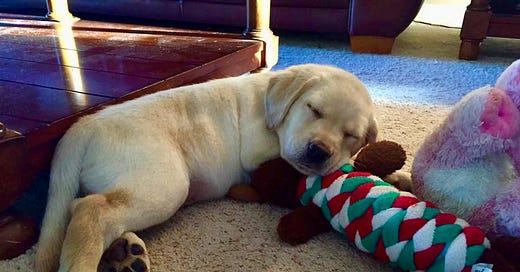#391: Why Saying "No" on Day One is Like Giving Up on a Puppy
Explore how saying "no" too early in the sales process could be stifling innovation and growth.
Imagine being a carbon wire sales rep in the late 1800s, and an inventor kept asking for samples for an experiment he was running. He explained what he was trying to do, and you thought it was a crazy idea, so you said no. You had to meet your quota, and giving away samples wasn’t a way to do that. A few years later, you are reading about an inventor named Edison, who had 10,000 failures of his new invention but finally succeeded in creating the light bulb.
Do you think Tom would take your call?
(Carbon wire was the first filament used in Edison’s light bulb)
This reminds me of a quote I heard years ago:
“Our sales process is over 700 days long; day one is not the day to say no!” Author Unknown
Over the years, my time in sales was often spent developing businesses with custom-engineered solutions. By the nature of that business, we frequently came in contact with people who had wild ideas and liked to spin our wheels. The engineering departments I worked with would usually look at the problem to be solved and say no—not out of feasibility but due to budgeting time. They loved to say no on day one.
What’s the problem with that attitude?
This mindset can lead to stagnation. How do they stay stimulated by only accepting projects that they are comfortable with? Slogging through the day with tasks and development time, recreating only things they have done before, shuts down creativity. If you rely on innovation to succeed, this is a danger to your long-term viability.
More critical than stagnation, saying 'no' on day one can inadvertently close doors to potential business relationships. We may miss out on valuable opportunities by dismissing a prospect too early. No matter how brief, each interaction is a chance to build rapport, understand their needs, and position ourselves as a trusted advisor. A premature 'no' can deprive us of the opportunity to nurture a relationship that could lead to a long-lasting partnership.
Just as a puppy needs time, patience, and encouragement to learn a new skill, a potential customer may require a similar approach in the sales process. Saying "no" too early can be akin to giving up on a puppy before it has fully grasped a concept. Patience is essential, whether it’s a wild idea from an inventor or a new relationship with a company trainee. They may or may not become the best customers or employees, but you can help them improve.
The Power of Curiosity and Openness
In sales, as in life, curiosity can be your greatest asset. Instead of dismissing an idea as "crazy," approach it with questions. What problem are they trying to solve? How does this fit into their larger vision? By engaging with curiosity, not only do you learn more about the potential customer's needs, but you also demonstrate genuine interest. This approach can turn a simple inquiry into a foundation for a long-term relationship, mirroring how Edison's curiosity led him to thousands of experiments before the light bulb.
The Long Game in Sales
Sales, particularly in fields ripe for innovation, require patience. Edison didn't invent the light bulb overnight; it was a process of persistence. Similarly, every interaction with a client should be viewed as part of a long-term strategy. Nurturing these relationships over time, even if they don't immediately yield results, can lead to breakthroughs. Encourage sales professionals to think of their role as more than closing deals. They are planting seeds that might grow into significant partnerships.
Risk Management in Innovation
Balancing between innovation and operational efficiency is key. While resources are finite, there's value in taking calculated risks. Consider establishing a "risk fund" or a portion of time dedicated to exploring unconventional ideas. This approach allows for innovation without jeopardizing core business operations, teaching sales teams to manage risk while still encouraging creative exploration.
Building Trust Through Education
When an idea seems unfeasible, use it as an opportunity to educate. Instead of a flat "no," explain the challenges and explore alternatives. This not only educates the customer but also positions you as a knowledgeable partner. Over time, this educational approach builds trust, making future collaborations more likely and fruitful.
The Art of Saying 'Yes, But...'
Mastering the art of conditional agreement can keep doors open. Instead of outright rejection, responses like "Yes, we can explore this, but here are the challenges we foresee..." manage expectations while maintaining engagement. This technique encourages further dialogue and shows willingness to work towards a solution, even if not immediately possible.
Just as a good salesperson doesn’t hear the word no, they should avoid verbalizing it themselves.




